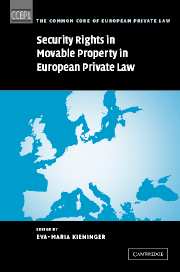Book contents
- Frontmatter
- Contents
- General editors' preface
- Preface
- List of contributors
- Table of cases cited by name
- Table of legislation
- Part I Introduction and context
- List of abbreviations
- 1 Introduction: security rights in movable property within the common market and the approach of the study
- 2 A labyrinth of creditors: a short introduction to the history of security interests in goods
- 3 Security in movables in the United States – Uniform Commercial Code Article 9: a basis for comparison
- 4 The English law of security: creditor-friendly but unreformed
- 5 The European Bank for Reconstruction and Development's Secured Transactions Project: a model law and ten core principles for a modern secured transactions law in countries of Central and Eastern Europe (and elsewhere!)
- Part II The case studies
- Index by country
- Index by subject
4 - The English law of security: creditor-friendly but unreformed
Published online by Cambridge University Press: 23 December 2009
- Frontmatter
- Contents
- General editors' preface
- Preface
- List of contributors
- Table of cases cited by name
- Table of legislation
- Part I Introduction and context
- List of abbreviations
- 1 Introduction: security rights in movable property within the common market and the approach of the study
- 2 A labyrinth of creditors: a short introduction to the history of security interests in goods
- 3 Security in movables in the United States – Uniform Commercial Code Article 9: a basis for comparison
- 4 The English law of security: creditor-friendly but unreformed
- 5 The European Bank for Reconstruction and Development's Secured Transactions Project: a model law and ten core principles for a modern secured transactions law in countries of Central and Eastern Europe (and elsewhere!)
- Part II The case studies
- Index by country
- Index by subject
Summary
Article 9 through the eyes of an English lawyer
To understand the character of English law in general, it is always helpful to compare it with United States law, which is both similar and different. English law and US law may both be common law systems, the latter developing out of the former, but the differences between them are highly significant. It is increasingly difficult for lawyers as practitioners or academics to migrate between the two systems.
If one descends to the particular and looks at the structure of the rules dealing with secured transactions, fundamental differences between English law and US law appear to surface. Yet a close examination of the two laws reveals that both are at root alike in the friendly response they give to secured credit. Furthermore, the differences between the two laws are, to a significant extent, differences of legislative style. If one were to take the existing body of English rules on personal property security and restate them in US legal terminology, the result would probably be not greatly different from US Article 9 UCC. The basic values of the two systems of law are very similar.
The dominant feature of US law in the area of secured transactions is its commitment to the guiding principles of the jurisprudential movement known as American realism. This philosophy manifests itself in an impatient attitude to conceptual differences that conceal an identity of function.
- Type
- Chapter
- Information
- Publisher: Cambridge University PressPrint publication year: 2004



